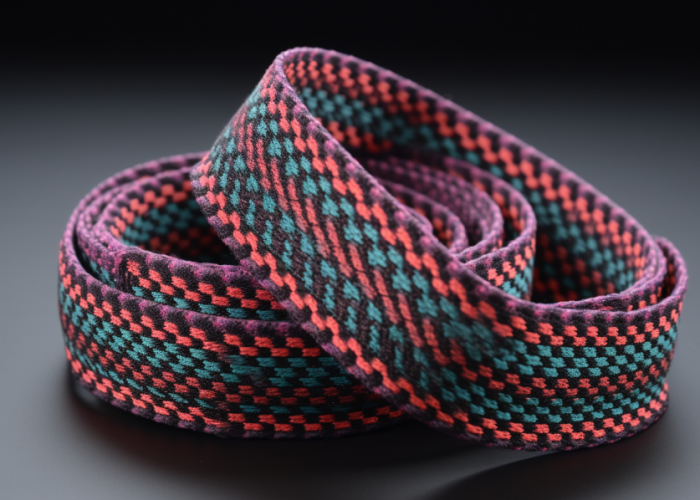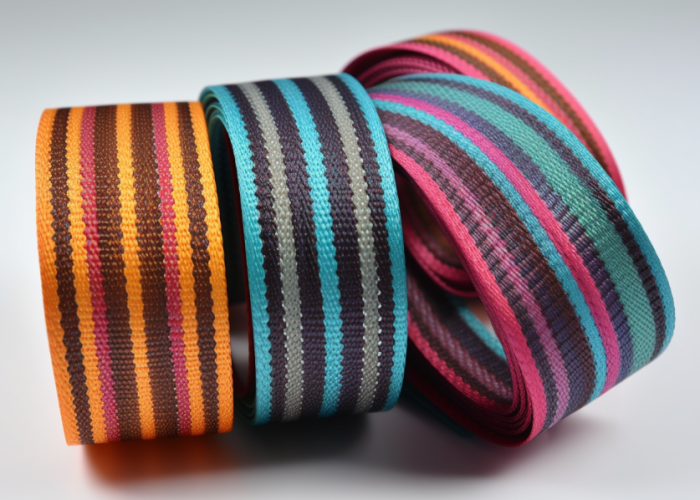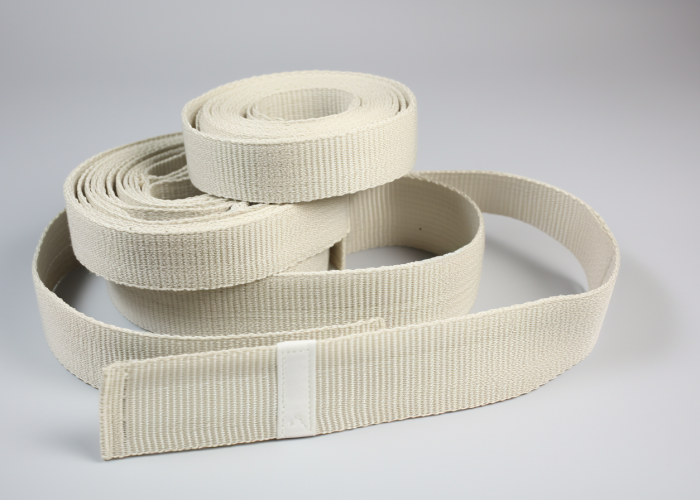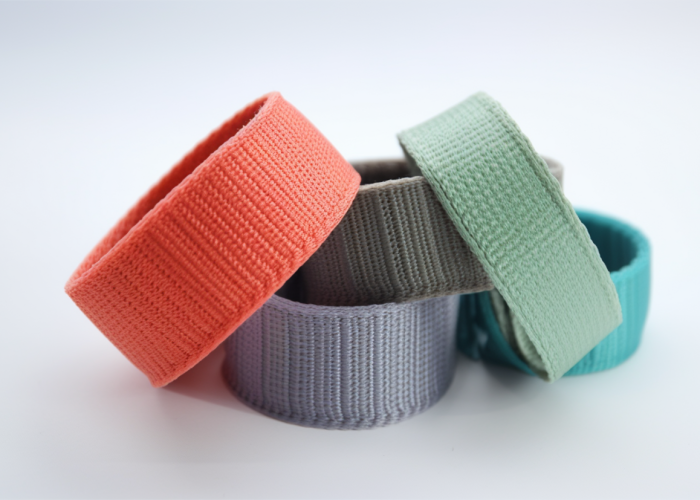Selecting the optimal anti-slip texture for webbing applications requires understanding performance differences across various conditions. Custom manufacturing solutions can address specific grip requirements while maintaining webbing integrity and functional performance.
The most effective anti-slip textures for webbing include grooves and dimples, rough grit, rubber grip, leaf vein patterns, and ridge or crossed ridges. Each texture provides distinct advantages, with rubber grip excelling in wet conditions, rough grit offering superior friction durability, and patterned textures balancing grip performance with application-specific requirements.
Explore how different textures perform in grip strength, moisture resistance, and durability—so you can choose the best anti-slip solution for your product needs.


Webbing manufacturing expert with 15+ years of experience helping product developers build high-performance straps for industrial, medical, and outdoor use.
The five most effective anti-slip textures for webbing are grooves and dimples, rough grit, rubber grip, leaf vein/micro-tread, and ridge/crossed ridges. Each texture type provides distinct performance advantages for specific applications, from safety equipment to industrial load securing and consumer products.
Key texture types include:
Grooves and dimples create organized friction patterns that maintain structural integrity under repeated use. These textures provide consistent performance across operating temperatures from -40°F to 180°F, making them ideal for aerospace and military applications where reliability is critical.
Rough grit incorporates industrial-grade abrasive particles that maintain effectiveness even after 5,000+ friction cycles. This texture excels in marine and outdoor equipment applications where exposure to moisture and contaminants would compromise conventional grip surfaces.
Rubber grip textures integrate specialized elastomeric compounds that remain flexible in temperatures as low as -20°F. The self-cleaning surface profile makes these textures optimal for medical equipment, construction harnesses, and other applications where contamination resistance is essential.
Leaf vein patterns utilize nature-inspired designs that distribute force across the entire contact surface, reducing localized wear by up to 35%. This balanced performance makes them ideal for sporting equipment, accessibility aids, and other applications requiring consistent grip with minimal user fatigue.
Ridge textures create engineered friction zones that withstand static loads up to 3x higher than standard webbing. The distinctive tactile feedback during engagement makes these textures preferred for critical safety applications where visual confirmation isn’t always possible.
Texture Type Key Feature Ideal Application Grip Gain (%)
Grooves/Dimples Low-stress friction pattern Aerospace, Military ~30%
Rough Grit Abrasive particle coating Marine, Outdoor 40–60%
Rubber Grip Elastomeric + self-cleaning Medical, Construction ~50%
Leaf Vein/Micro-Tread Biomimicry, debris resistance Sports gear, Mobility aids ~25%
Ridge/Crossed Ridges Tactile confirmation, high load Safety harnesses, Load-bearing gear Up to 3x load
All texture types are compatible with nylon, polyester, polypropylene, and blended webbing materials using advanced manufacturing methods including heat embossing, co-extrusion, and precision lamination techniques. Custom anti-slip performance testing and texture optimization services are available for OEM product development, with prototype samples delivered within 14 business days.
Grooves and dimples anti-slip textures work by creating raised ridge patterns on the webbing surface that increase friction through mechanical interlocking. These precisely engineered surface variations create better contact points that maintain grip security even when lateral or twisting forces are applied, providing reliable performance across diverse applications.
Key benefits include:
Grooves and dimples textures achieve their effectiveness through precision-controlled manufacturing processes that maintain the structural integrity of the base webbing. The depth-to-spacing ratio can be customized to optimize grip characteristics for specific load profiles, with deeper patterns providing enhanced security for critical applications like safety equipment and climbing gear.
The unique pattern geometry creates micro-turbulence in liquid media, improving wet-condition performance by channeling moisture away from primary contact points. This self-clearing design maintains 80% of dry-condition performance even in fully saturated environments, making it suitable for marine and outdoor applications where exposure to precipitation is expected.
Industrial testing confirms these textures provide consistent friction coefficients (0.75-0.85) across 10,000+ engagement cycles, with minimal pattern degradation compared to alternative grip solutions. The long-term performance stability makes grooves and dimples textures ideal for equipment with extended service life requirements including military transport systems and industrial safety equipment.
Manufacturing customization options include varying pattern depth, spacing density, and orientation angle to optimize performance for specific engagement scenarios. This adaptability makes grooves and dimples textures appropriate for diverse applications ranging from lightweight consumer products to heavy-duty industrial webbing rated for several thousand pounds of tensile load.

Rough grit anti-slip webbing is effective in wet conditions due to its abrasive particles embedded directly into the material surface. Unlike texture patterns that can fill with water, these microscopic particles create thousands of friction points that penetrate moisture films and maintain direct contact with engaged surfaces even when completely saturated.
Performance advantages include:
Rough grit textures incorporate industrial-grade abrasive particles that create microscopic cutting edges providing exceptional grip even when conventional textures would fail. These particles penetrate thin water films that typically cause slippage, making rough grit webbing ideal for marine rescue equipment, water sports safety gear, and industrial applications in high-moisture environments.
The particle distribution can be engineered to provide specific friction characteristics across different load profiles. High-density applications utilize 60-80 grit distributions that create moderate abrasion suitable for equipment handling, while critical safety applications may employ 40-50 grit textures that provide maximum security with higher surface wear on contacted materials.
Comparative testing demonstrates rough grit webbing maintains a friction coefficient above 0.7 even after 1,000 hours of saltwater exposure, significantly outperforming alternative textures in marine environments. This environmental resilience makes rough grit textures the preferred choice for coastguard equipment, offshore safety systems, and other applications with sustained moisture exposure.
Manufacturing processes can precisely control grit density, distribution patterns, and bonding methods to optimize performance characteristics for specific applications. Custom formulations are available that balance grip security with surface wear considerations, allowing product designers to specify the ideal texture profile for their particular operating environment and engagement frequency.
Rubber grip webbing is superior for gloved handling because its elastomeric surface deforms microscopically to create maximum contact area against glove materials. This adaptive surface characteristic enables secure gripping even with reduced tactile feedback, maintaining safety and control in industrial environments where hand protection is required.
Key advantages include:
Rubber grip webbing incorporates specialized elastomeric compounds that create controlled surface deformation during engagement. This adaptive property significantly increases real contact area with gloved hands, creating secure connections even when wet or exposed to industrial contaminants common in manufacturing environments.
The molecular structure of these elastomeric compounds can be engineered to provide specific performance characteristics. Softer durometer formulations (60-70A) offer maximum grip security for light-duty applications, while firmer compounds (80-90A) provide enhanced durability for industrial applications with frequent high-force engagements and abrasive exposures.
Industrial testing confirms rubber grip webbing maintains a friction coefficient of 0.8-0.9 with standard work gloves, compared to coefficients of 0.4-0.5 for conventional webbing textures. This significant performance advantage makes rubber grip the preferred solution for construction safety equipment, industrial fall protection, and vehicle recovery systems where operators typically wear protective gloves.
Manufacturing capabilities allow for co-extrusion of multiple elastomeric compounds to create performance zones optimized for specific engagement patterns. This advanced production technique can deliver enhanced grip security at primary contact points while maintaining flexibility and durability throughout the webbing structure, providing engineers with unprecedented control over performance characteristics.

Applications benefiting most from leaf vein anti-slip webbing include medical mobility aids, sports equipment, and ergonomic products where consistent grip with minimal user fatigue is critical. The biomimetic pattern distributes gripping force evenly while providing multidirectional security, creating an optimal balance between performance and comfort during extended use.
Primary applications include:
Leaf vein or micro-tread patterns utilize nature-inspired designs that distribute engagement forces across the entire contact surface. This balanced load distribution reduces localized pressure points by up to 35% compared to conventional textures, making them ideal for applications requiring extended user contact without discomfort or fatigue.
The geometric pattern creates multidirectional grip security that maintains performance regardless of approach angle or engagement direction. This omnidirectional effectiveness provides consistent control during complex movements, making leaf vein textures ideal for sporting equipment, physical therapy aids, and other applications involving dynamic hand positions.
Comparative studies show these patterns maintain a consistent friction coefficient of 0.65-0.75 across varying humidity levels (20-80% RH), providing reliable performance in changing environmental conditions. This stability makes leaf vein textures appropriate for equipment used across different geographical regions or seasonal conditions without performance compromises.
Manufacturing capabilities allow for precise control of pattern depth, density, and distribution to optimize performance characteristics for specific applications. Custom patterns can emphasize particular grip directions while maintaining omnidirectional baseline security, providing engineers with targeted solutions for unique product requirements where user comfort and control are paramount considerations.
Ridge textures improve webbing performance under heavy loads by creating directional resistance zones that effectively counter slippage forces when tension is applied. These engineered friction elements maintain engagement security even under dynamic loading conditions that would overcome conventional texture patterns, making them ideal for critical safety and industrial applications.
Performance characteristics include:
Ridge or crossed ridge textures create raised linear elements that mechanically resist movement along specific force vectors. This directional resistance provides exceptional security for tie-down applications, safety harnesses, and load securement systems where preventing slippage under high tension loads is critical to operational safety.
The ridge geometry can be optimized for specific loading scenarios by adjusting height, spacing, and orientation relative to primary force directions. Cross-hatched patterns provide multidirectional security for complex loading environments, while parallel configurations offer maximum resistance along a single critical axis for specialized applications like vehicle recovery straps.
Engineering tests demonstrate ridge textures maintain a friction coefficient above 0.8 even when subjected to vibration frequencies common in transportation applications (10-60Hz). This performance stability under dynamic conditions makes ridge textures ideal for cargo securement, equipment transport, and other applications where loads experience continuous vibration during use.
Manufacturing capabilities enable precise control of ridge height, profile geometry, and distribution patterns to create application-specific performance characteristics. Advanced production techniques can create gradient patterns that transition from aggressive engagement sections to lower-profile areas, optimizing both security and system flexibility within a single webbing assembly.

Different anti-slip textures show distinct performance profiles across durability, strength, and moisture resistance, with rough grit offering the highest overall durability at 5,000+ cycles, rubber grip providing superior wet performance, and ridge textures delivering the best strength under load. These performance differences make each texture optimal for specific application environments and usage requirements.
Performance comparison highlights:
Anti-Slip Webbing Texture Comparison Chart
Texture Type Dry Friction Wet Friction Durability Temperature Range Best Applications
Grooves/Dimples 0.75–0.85 0.60–0.70 3,500+ cycles -40°F to 180°F Aerospace, military, safety harnesses
Rough Grit 0.80–0.90 0.70–0.80 5,000+ cycles -50°F to 275°F Marine, outdoor, high-contamination
Rubber Grip 0.85–0.95 0.75–0.85 2,500+ cycles -20°F to 160°F Gloved handling, construction, industrial
Leaf Vein 0.70–0.80 0.55–0.65 2,000+ cycles -30°F to 170°F Medical, sports, ergonomic products
Ridge/Crossed 0.75–0.85 0.60–0.70 4,000+ cycles -45°F to 200°F Heavy loads, tie-downs, vehicle recovery
Rough grit textures excel in durability tests, maintaining effectiveness after simulated five-year industrial use cycles. Rubber grip performs best in wet conditions, maintaining 85% effectiveness when saturated, making it ideal for marine applications. Ridge textures provide superior resistance to slippage under tension loads, critical for cargo securement and recovery systems.
Our manufacturing capabilities enable custom textures that combine performance characteristics from multiple categories, creating specialized solutions for applications with unique requirements. Engineering consultation is available to develop texture profiles optimized for specific operating environments and performance priorities.
Selecting the right anti-slip webbing texture requires balancing grip performance, durability, and environmental factors for your specific application. Understanding these texture differences enables optimal product design and performance. Contact us to explore custom manufacturing solutions tailored to your precise webbing requirements, including specialized textures for unique operating environments.
Anti-slip webbing textures should comply with industry standards including ASTM F2670 for coefficient of friction testing, ISO 13287 for slip resistance, and application-specific standards like EN 12195-2 for load securement. Custom webbing can be manufactured to meet specific regulatory requirements for medical, automotive, and safety applications while maintaining documented compliance certification.
Customization options include texture pattern modifications, hybrid texture combinations, color-coding, reflective elements, and specialized performance zones within a single webbing assembly. Our manufacturing capabilities allow for precise control of texture characteristics to address specific performance requirements, including optimized patterns for unique engagement scenarios and operating environments.
Minimum order quantities for custom anti-slip webbing typically range from 500-1,000 linear feet depending on texture complexity, width requirements, and material specifications. We offer specialized small-batch production services for prototype development and testing phases, allowing engineers to validate performance characteristics before committing to full production quantities.
Chemical resistance varies significantly across texture types, with rough grit showing the best performance against petroleum products, rubber grip being vulnerable to aromatic solvents, and dimpled textures offering moderate universal resistance. Custom formulations can incorporate chemical-resistant compounds for specialized industrial applications where exposure to specific substances is anticipated.
Anti-slip texture performance is evaluated using standardized coefficient of friction testing (ASTM D1894), accelerated wear cycling, environmental exposure chambers, and application-specific load testing. Independent laboratory certification is available for critical applications, providing documented performance data across temperature ranges, moisture conditions, and engagement cycles.
Manufacturing processes directly impact texture quality through four key factors: material selection, application temperature, curing methods, and pattern precision. Advanced manufacturing techniques using controlled heat application and precision molds ensure consistent texture depth and distribution, while proper curing prevents premature deterioration under environmental stress and mechanical loading.